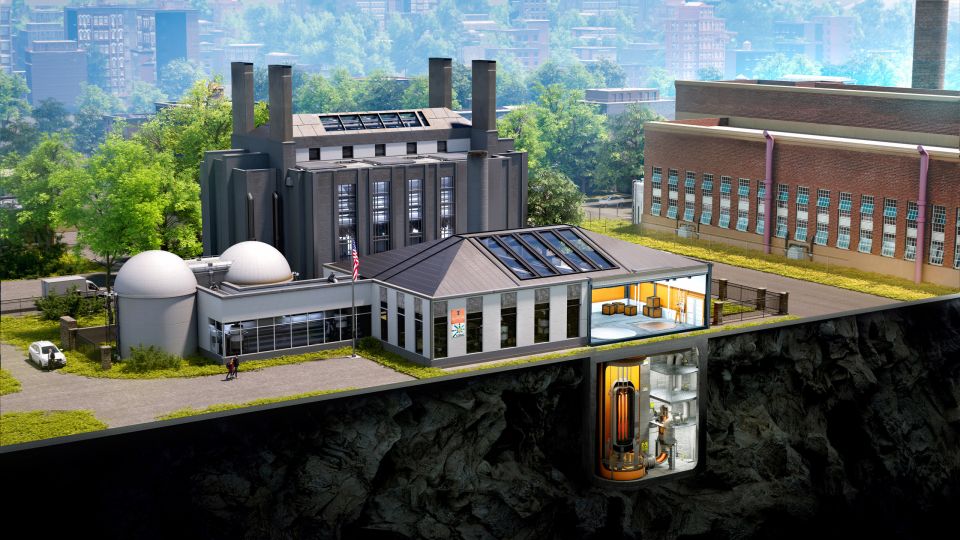Lifted moratorium will allow Illinois to build new nuclear reactors

This prototype design shows a small modular reactor that the University of Illinois at Urbana-Champaign’s nuclear engineering department plans to build. The department is collaborating with the U.S. Nuclear Regulatory Commision on the project. Photo from the University of Illinois Nuclear, Plasma and Radiological Engineering website
Governor J.B. Pritzker signed a bill into law Friday that will lift the three-decade moratorium on developing nuclear reactors.
The law, which takes effect in June 2024, will allow the development of generation IV power plants, which are also known as small modular reactors or SMRs. Currently Illinois, and most other states, use generation II reactors.
Illinois generates more nuclear energy than any other state, according to the U.S Energy Information Administration, and has a stated goal to get to 100% clean energy by 2050, which will mean replacing fossil fuels with renewable and nuclear energy sources.
SMRs have not operated in the U.S. yet, however, the world’s first was recently built in China, according to Reuters. Generation IV reactors have many benefits including their reduction of waste, according to David Ruzic, a nuclear engineering professor at the University of Illinois at Urbana-Champaign.
“They burn up their own nuclear wastes. They actually use that as fuel and so they have much, much less of those long-lived wastes, which is a big advantage,” Ruzic said. “Another thing about them is that they actually have a safety system that’s just based on the laws of physics. Turns out if it gets too warm, it shuts itself off.”
Ruzic also expects SMRs will be less expensive than current nuclear reactors, once the technology is fully developed; and since they are modular, they will be easier to build.
“A modular reactor is built in a factory and… pieces of it come on a truck, and you just put it together. And that means it has the potential of being much cheaper,” Ruzic said. “You can make more of them, and it's small, so the small modular reactors have a real chance for an economic impact.”
But generation IV reactors, at least initially, will be very expensive to build. This is one of the reasons why some environmental advocacy groups oppose investing in nuclear energy.
Jack Darin, director of the Illinois Chapter of the Sierra Club, said the legislation goes against Illinois’ original plan to focus on renewable energy sources, like wind and solar, to replace fossil fuels such as petroleum, natural gas and coal.
“And we just need to stay that course,” Darin said. “We're concerned that if we start opening the door to extremely expensive forms of energy like nuclear, that we might stray off the path to 100% renewable energy.”
Darin said another concern for nuclear energy is the management of radioactive waste. He said Illinois has more nuclear waste than any other state, which was one of the main reasons it implemented the moratorium.
“Building new nuclear reactors is adding to that problem when there's not only no solution, but not even a plan to have one anytime in anyone's lifetime,” Darin said. “We just think it is adding to what is going to be a very expensive problem for generations to come and could be a very dangerous one.”
Ruzic said there are often misconceptions about the volume of waste produced by the current power plants in Illinois. He said the volume of high-level wastes that are produced by a singular power plant are significantly less than the volume of waste from other energy sources such as coal.
“If I power a nuclear power plant for one year, all of the waste, that high-level, nuclear waste, fits under one chair,” Ruzic said. “If you run a coal power plant, the coal ash builds a mountain. That coal ash has chemical carcinogens in it. It actually even has radioactive elements.”
Ruzic said one problem with relying on renewable energy to replace fossil fuels is that wind and solar are intermittent power sources.
“Unless you say, ‘Wow, I just won't use any electricity at night, or when the wind stops,’” he said. “You have to have a concentrated form of energy. If you want… one that's extremely safe, and doesn't cause pollution, then you should use nuclear.”
The timeline for the construction of the new reactors will depend on when the report about safety and guidelines is finished. The report is due in 2026, according to the Associated Press. Ruzic said he expects to start seeing small modular reactors around the state within the next five to ten years.
Researchers at UIUC hope to be among those developing small modular reactors in the state. In 2021, the university submitted an application to the U.S. Nuclear Regulatory Commission (NRC) to build a test facility for a SMR on campus.
Currently the UIUC is still collaborating with NRC to finalize this project, according to its website.

